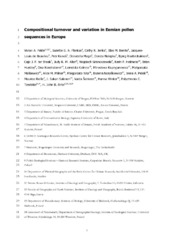Compositional turnover and variation in Eemian pollen sequences in Europe
Felde, Vivian Astrup; Flantua, Suzette; Jenks, Cathy; Benito De Pando, Blas Manuel; de Beaulieu, Jacques Louis; Kuneš, Petr; Magri, Donatella; Nalepka, Dorota; Risebrobakken, Bjørg; ter Braak, Cajo J.F.; Allen, Judy R. M.; Granoszewski, Wojciech; Helmens, Karin F.; Huntley, Brian; Kondratienė, Ona; Kalnina, Laimdota; Kupryjanowicz, Mirosława; Malkiewicz, Małgorzata; Milner, Alice M.; Nita, Małgorzata; Noryśkiewicz, Bożena; Pidek, Irena A.; Reille, Maurice; Salonen, J. Sakari; Šeirienė, Vaida; Winter, Hanna; Tzedakis, P. Chronis; Birks, Harry John Betteley
Peer reviewed, Journal article
Accepted version
Permanent lenke
http://hdl.handle.net/1956/20242Utgivelsesdato
2019Metadata
Vis full innførselSamlinger
Originalversjon
https://doi.org/10.1007/s00334-019-00726-5Sammendrag
The Eemian interglacial represents a natural experiment on how past vegetation with negligible human impact responded to amplified temperature changes compared to the Holocene. Here, we assemble 47 carefully selected Eemian pollen sequences from Europe to explore geographical patterns of (1) total compositional turnover and total variation for each sequence and (2) stratigraphical turnover between samples within each sequence using detrended canonical correspondence analysis, multivariate regression trees, and principal curves. Our synthesis shows that turnover and variation are highest in central Europe (47–55°N), low in southern Europe (south of 45°N), and lowest in the north (above 60°N). These results provide a basis for developing hypotheses about causes of vegetation change during the Eemian and their possible drivers.
